Pat Bertram's Blog, page 13
September 14, 2022
What a Horror!
I spent the morning digging Bermuda grass out of one of the half-circle flower beds along the front ramp. It seems as if I’ve done this same cleanup in this same garden several times before, and no wonder — I have. I’ve done the fall cleanup three years in a row, as well as pulling weeds at various times during the summer each of those years. I gave up a couple of months ago, and oh, my. What a horror! Thick grass with three- and four-foot stolons and me with bad knees.
It’s actually easier to dig up an entire bed than to dig around existing plants, but I keep hoping those existing plants — daylilies — will spread and multiply and take over the whole garden. So far, it hasn’t happened.
I’m considering doing something else next year — perhaps not plant anything and wait to see what comes up. Tulips will come up, I hope, and after they die back, I’m sure the larkspur will also come up. Around here, larkspur is a short-lived plant, so after I’ve cleared out the dead stalks, I’ve been planting other things to fill in the garden while the daylilies decide what they want to do.
Maybe it’s not that important to have flowers in the front all season. Maybe it’s more important to baby the daylilies and try to keep the garden free of grass for a year and see what happens. (I suppose I could buy a grass killer that’s made especially for flower gardens, but I hesitate to fill my yard with chemicals, and anyway, it’s almost impossible to kill Bermuda grass.)
A few days ago, I wrote about gardening being an all-encompassing creative endeavor, using mind, eyes, hands, heart, and body. It’s also very much a learning experience, which makes it a good project for me because above everything else, I love to learn.
And today’s lesson was all about Bermuda grass. I have a first-hand knowledge of the weed from my efforts to contain the grass the past couple of years, but there is still much I didn’t know. It turns out the scientific name for Bermuda grass is Cynodon dactylon, though it goes by many names besides Bermuda grass, such as quickgrass, twitch grass, and couch grass. It is a weed found all over the world, probably originating in sub-Saharan Africa or perhaps on islands in the western parts of the Indian Ocean. It’s called Bermuda grass because it was introduced to the USA via Bermuda. Although around here, Bermuda grass is used for lawns because of its tolerance for sun and heat, it is considered one of the world’s most invasive weeds, one moreover, that is almost impossible to get rid of.
So, despite having learned all that about my nemesis, it certainly doesn’t help me any in trying to get rid of it. That stuff is truly scary. Even though I have a weed barrier underneath the rocks around the house and my pathways, the Bermuda grass pokes it way to the sun. And if it can’t poke through the barrier, it will grow from far beneath the path and emerge along the edges, which makes it impossible to get rid of. Sure, I can dig it up, but because I can’t get to the origin of the root, it just grows back.
Eventually, I’m sure, I’ll have to make some sort of accommodation with the relentless stuff, but if I give up the fight, I’ll end up with a huge mess.
That brings me back to the beginning premise of this essay, and my musing about not planting anything in this particular garden and see if dedicating myself to the task of clearing out the weed will help. Actually, I’m sure it will — until next year when I go back to planting and watering that garden. Then, all the bits of roots and stolons and seeds and biological detritus that I couldn’t completely eradicate, will erupt into new plants, and I’ll be back where I started from.
Still, things do manage to grow despite the horror of the gardening world. In fact, speaking of larkspur as I did above, I found these two dainty flowers today.

***

What if God decided S/He didn’t like how the world turned out, and turned it over to a development company from the planet Xerxes for re-creation? Would you survive? Could you survive?
A fun book for not-so-fun times.
Click here to buy Bob, The Right Hand of God.
September 13, 2022
That Notorious Villain Mr. Death
I received an email with sad news today: a dear friend is coming to the end of her days. A year and a half ago, the doctors said she had only two months to live, but she managed to survive happily and with grace all this time. But now, the cancer is too advanced, and chances of her surviving much longer are slim.
One of the saddest things about living to a certain age is that death seems to have become a constant presence. So many people I’ve been close to for years are gone, and those I’ve met more recently, are also going. I’ve only known this woman about three years, but despite a bit of a language problem (she spoke English with an accent I had a hard time understanding), we became instant sisters. And now I’m about to lose one more person to that notorious villain, Mr. Death.
I seem to be beset by death today. I spoke to another friend, a woman who lost her husband to The Bob, and she mentioned she’d checked a couple of my books out of the library. She had tears in her eyes when she said that my books on grief were the best books she’d ever read on the subject. It’s good to hear that, of course, and I am glad I was able to help in any way, but I would have been even gladder if none of us were in the position of knowing so much about grief in the first place.
Interestingly, she’d recommended my books to another recent widow, and that woman went to the library, but instead of checking out my grief books, she got one of my fiction books. That would have been my choice! It’s hard enough being steeped in one’s own grief without adding another person’s grief on top of yours.
I was glad to know they got the books from the library. I’d donated the books, and I worried that if the books sat on the shelf too long the librarians would get rid of them. (In other places, I’ve seen new books donated by their authors that ended up on a sale rack for 10 or 25 cents, and I didn’t want my donation to go to waste. Luckily, so far, the library has kept them.)
I’ve been gradually shifting away from the original topic — the sad news about my friend — but truly, what else is there to say except that I was honored she considered me a sister and how sad I am that she’s nearing the end. My heart (and a few tears) goes out to her husband who has so devotedly taken care of her the past couple of years.

***

Pat Bertram is the author of Grief: The Inside Story – A Guide to Surviving the Loss of a Loved One. “Grief: The Inside Story is perfect and that is not hyperbole! It is exactly what folk who are grieving need to read.” –Leesa Healy, RN, GDAS GDAT, Emotional/Mental Health Therapist & Educator.
September 12, 2022
Mostly Flowers
This is a quickie post, mostly photos of my flowers that are blooming today because I’ve run out of time for anything more time consuming.
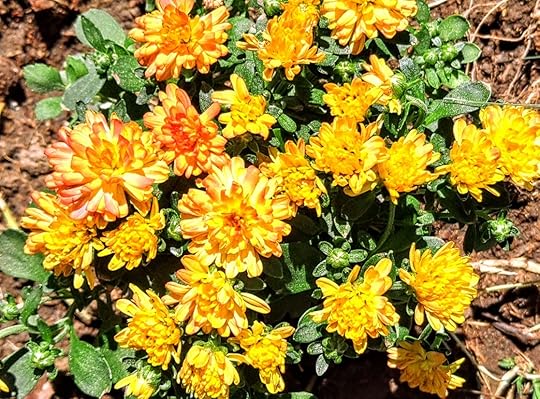
The weather was cool and still with bright blue skies, so I stayed outside working much longer than I should have. I cleaned weeds from around the edge of a garden so I was able to do much of it sitting, which helped protect my knees.

Besides spending too much time outside, I just got a text asking me to go in to work earlier, so here I am, in a hurry, so I’m showing off my photography skills instead of my writing skills.
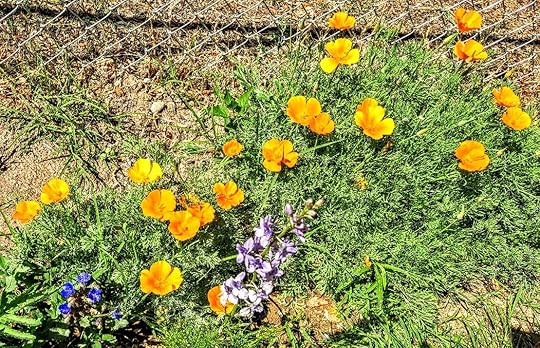
I’m sure you’re just as glad to see photos instead of another essay about grass, though I won’t let you completely off the hook. As I was cleaning out the gardens on either side of my front ramp, I noticed a tangle of four-foot-long Bermuda grass stolons (above ground stems) beneath the ramp on the original sidewalk. I thought maybe the grass was growing out of the cracks, but it turned out that the grass on one side of the ramp was inching toward the other side and vice versa. Apparently, even grass itself thinks things are greener on the other side.

I’m still astonished by the growth of my New England asters this year. If anyone local wants any when it comes time to divide them, be sure to let me know.
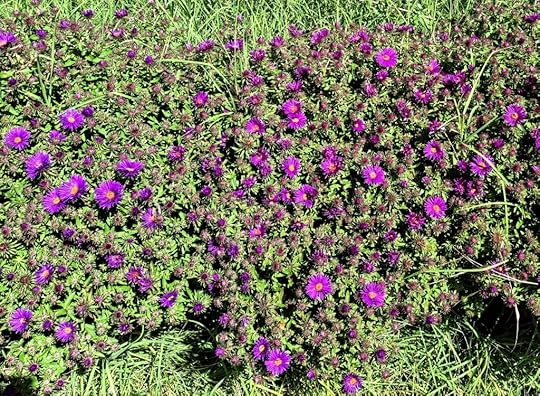
Well, I’ve run out of time, so it’s off to work I go.
***

What if God decided S/He didn’t like how the world turned out, and turned it over to a development company from the planet Xerxes for re-creation? Would you survive? Could you survive?
A fun book for not-so-fun times.
Click here to buy Bob, The Right Hand of God.
September 11, 2022
A Grass-Filled Day
I experienced a bit of a dichotomy today. I spent the first couple of hours in my yard planting grass, and the second couple of hours pulling up grass.
I suppose it’s not as bad as it sounds, or as bad as it felt while I was doing these two tasks because I was working in two separate gardens, and the grasses were completely different from one another — one was a turf grass and the others were weedy grasses. I might not have paid attention to the weedy grasses but the recent chill as well as a mist of rain and high humidity made all those grasses go to seed. Not only was it unsightly, but I certainly don’t want to deal with even more weedy grasses next year. So I took the time to pull up the grass.

This problem I have with weedy grass is a good example of what happens when you remove one type of organism or organic material from an ecological niche. Last year, this island garden (as I call the strip of ground surrounded by sidewalks) was inundated with Bermuda grass. I managed to dig up most of it, thinking that would be the end of the problem, but no. Immediately other grasses rushed in to fill the niche.
Oddly, when I could have used all these grasses to create a semblance of a lawn, none were around. All I had were small patches of Bermuda grass and a whole lot of tall weeds like ragweed, kochia, and wild mustard.
Oh, well. The work keeps me busy and gives me an excuse to be outside. It’s supposed to be healthy — being outside — but even if it isn’t, I like expanding my reach and making use of the whole property, not just the house. It makes me feel . . . rich.
Now it’s just a matter of waiting to see if the turf grass grows as well as the weedy grass does. I’m having a lot of problem with the Bermuda grass encroaching on my lawn, but I’m not sure I care if the same thing happens in the area I planted today. I just need a way to access the back of the garden, it shouldn’t encroach on my expensive grass, and no matter what grass ends up there, it will all mow the same.
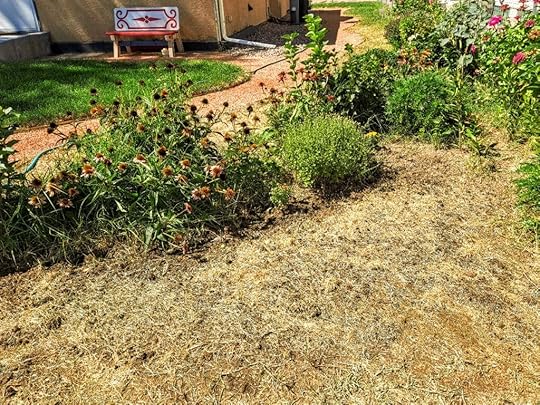
I hope you’re not as bored with this post as I am, but as always, I write about what’s on my mind, and today was a grass-filled day.
***

Pat Bertram is the author of Grief: The Inside Story – A Guide to Surviving the Loss of a Loved One. “Grief: The Inside Story is perfect and that is not hyperbole! It is exactly what folk who are grieving need to read.” –Leesa Healy, RN, GDAS GDAT, Emotional/Mental Health Therapist & Educator.
September 10, 2022
Unscheduled Hours
It’s amazing how many hours there are in a day when you don’t spend four hours working in the yard in the morning and four hours caregiving in the late afternoon.
Well, actually, there are the same number of hours in a day no matter what you are doing, but without all those hours of scheduled activity, there are a lot of free hours.
Normally, I’d be working outside doing something — cleaning out my overgrown gardens, for example — but it’s a cold, dark day and I don’t have to go to my job, so after a short walk, I’ve been treating myself to an entire day inside. So many hours to do nothing! Not that I do nothing, you understand, it’s that I could if I wanted to. Mostly I’ve been reading and relaxing and looking out the window, planning my next gardening project.
What struck me today is how, of all my creative endeavors over the years, gardening seems to be the most multi-faceted. Painters use their minds and eyes and hands to create their art. Writers use their minds and hands (or mouth if using speech-to-text software) to create their art. But gardeners use minds, eyes, hands, and bodies. (Sculpting is also physical, but since I’ve never sculpted, my premise can still stand. And anyway, a garden is a type of sculpture — a living sculpture.)
Where many artists and writers rely on their own knowledge and inspiration, letting paint or words flow from within, as a new gardener, I can’t do that since I have no “within” — no intrinsic knowledge of gardening. So in addition to the other facets of landscaping as an artform I’ve already listed, I’d have to add research. Lots of research. Not only do I need to learn what plants will work in this climate and in this soil, I have to learn how to care for them. Admittedly, I often get the plants or seeds first and then figure out what to do with them, but now that I’m becoming more familiar with this artform, I’m doing more preparation and planning.
Also, I am paying more attention to the aesthetics of my garden plots and the yard as a whole rather than just concentrating on each individual plant. Because of this, I’ve been doing more to sculpt the shape of the gardens and create a more pleasing balance, such as replacing low-lying plants with taller ones or vice versa. And standing at the window, looking out, gives me a broader view of the yard and a better sense of what I can do in the future.
So, even though I’m treating myself to a rare day inside, apparently, my thoughts are still outside.
But that’s okay. There are a lot of unscheduled hours in this chilly day to use however I wish.
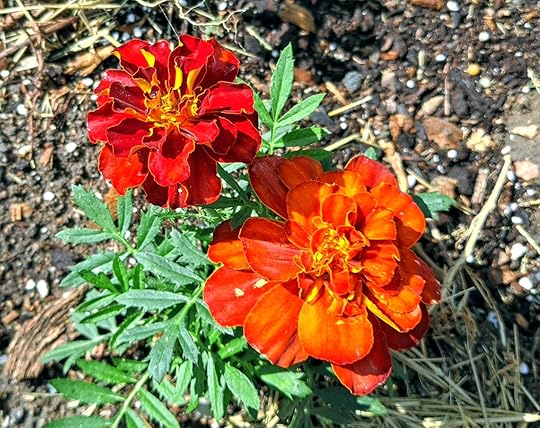
***

What if God decided S/He didn’t like how the world turned out, and turned it over to a development company from the planet Xerxes for re-creation? Would you survive? Could you survive?
A fun book for not-so-fun times.
Click here to buy Bob, The Right Hand of God.
September 9, 2022
There Will be Hope
There’s something very hopeful about preparing a new garden bed, not just the hope for new flowers, but hope for the future — hope that there will be a future. That hope keeps me going despite the hard work, and it is hard, even if the plot is only about 25-square feet. That’s a lot of digging, especially if what’s beneath the soil is a tangle of Bermuda grass roots as well as a tree root or two. (From a tree that was cut down years ago.)
I enjoy looking at that bare ground (well, bare except for the bits of vegetation that resist being raked up) and thinking about what I will plant. I know one thing I will plant are New England asters. When I first mentioned those plants years ago, a blog reader warned me that they tend to spread and even take over. In my smugness as a new gardener, I responded that I liked plants that spread because they save me from planting more. And I do like them. The problem is that the single stem I started with grew into a mass with several stems, so I divided them and replanted, and now each of those stems has become a clump of several stems. So now I need to figure out what to do with them all. A gardener friend wants some, so that’s a start. I know where I want a few more, so that’s good. In the end, I think, I’ll plant what’s left in my uncultivated area and let them take over. I bet they would lovely in a large mass!
Part of my newly cultivated area will be planted with grass — I need an area I can mow to give me access to the back of the garden. With no access, I ended up with a whole lot of weeds and weedy grasses. The lilies that were planted in that area rose above the weeds, and were lovely, but I want to give them less competition — except, of course, from the additional lilies I ordered a couple of days ago. Luckily, lilies don’t mind being crowded, so if my lilies — new and old — ever decide to multiply, I won’t have to divide them as I do with the asters. I’m still hoping for a lily forest. Apparently, it takes years for lilies to reach their full height, but a clearing in front of the lilies will help them and will help me help them.
As for what else I will plant — I’m not sure. I might just wait until spring and see if anything volunteers to grow in the area. Volunteers are those plants that grow on their own, sometimes seemingly appearing out of nowhere, though chances are they were seeds blown in on the wind or dropped from birds.
My favorite of these volunteers this summer has been the aptly-named heavenly blue morning glory. There have been one or two blooms every day for a couple of weeks now. I’m thinking of getting seeds and planting some on purpose next year, but sometimes, for me, the on-purpose plants don’t always grow as well as the volunteers.
Still, no matter what will go in the area I cleared today, there will be hope.

***

Pat Bertram is the author of Grief: The Inside Story – A Guide to Surviving the Loss of a Loved One. “Grief: The Inside Story is perfect and that is not hyperbole! It is exactly what folk who are grieving need to read.” –Leesa Healy, RN, GDAS GDAT, Emotional/Mental Health Therapist & Educator.
September 8, 2022
Treating Myself
Major doings today! A friend and I treated ourselves to a trip to the big city for a shopping spree, though to be honest, it’s only a big city in comparison to this tiny burg, and the shopping spree was merely to stock up on groceries.
Well, groceries and chrysanthemums in my case. The flowers weren’t a spur of the moment thing — I’d actually planned to buy a mum or two for my garden. They are such a nice addition — adding mounds of greenery during the summer, and copious flowers in the fall. Even better, they come in a variety of colors. A blog reader once sent me a photo of a park that has many mounds of mums with many colors, and I fell in love with the look. The plant already in the ground (bought last year) as well as the three starter plants I got today are a step in the right direction.
My friend teased me about buying more plants when she saw the mums in my cart, but I told her there is no such thing as too many plants, and that’s true, especially when it comes to perennials. More than half of the plants in my various gardens right now are annuals that will need to be replaced (unless, of course, they reseed themselves, which they might).
So, a nice drive, groceries to fill my empty refrigerator, chrysanthemums to plant — but wait, there’s more! After we finished shopping, we had lunch at an Asian restaurant. Pho for her, kung pao chicken for me. Imagine that — not just a treat, but a meal I didn’t have to prepare for myself.
Now I’m hiding inside. Outside temperatures are just shy of 100 degrees Fahrenheit (an interesting side affect of having international readers is that I finally learned how to spell Fahrenheit without the help of spellcheck), and even briefly stepping outside is enough to fry my skin. People always say, “but it’s a dry heat.” I do know firsthand that a humid heat makes people feel as if they are smothered in a hot, heavy, wet blanket, but dry heat sears. So basically, there is no such thing as a comfortable 100-degree day.
Tomorrow will be about twenty degrees cooler, and Saturday will be twenty degrees cooler than Friday, so that will be a big treat. (Lots of talk of treats today!)
I’m purposely not looking beyond Monday’s weather because Tuesday will be back in the nineties, yikes. Though maybe after a few cooler days, the heat will be a treat. But I doubt it.
Now that I’ve finished my blog stint for the day, I’ll be heading to the couch to read, and that, too is a treat — a comfortable perch, a book, and air-conditioning. Lovely.
I hope you managed to treat yourself today, too.

***

What if God decided S/He didn’t like how the world turned out, and turned it over to a development company from the planet Xerxes for re-creation? Would you survive? Could you survive?
A fun book for not-so-fun times.
Click here to buy Bob, The Right Hand of God.
September 7, 2022
Suffering for Art
I’ve never been one to believe in suffering for my art. Not that “my art” is actually art — it’s more in the line of pretty photos I’ve taken to memorialize some flowers I’ve grown. And if art isn’t worth suffering for, then pretty photos — no matter how attractive — definitely are not worth suffering for.
Actually, there wasn’t much pain or suffering involved, and it was a silly thing anyway that’s not much to talk about. And yet, here it is . . .
Last evening, when I got home from work, I noticed this bright orange zinnia, and wanted a photo.
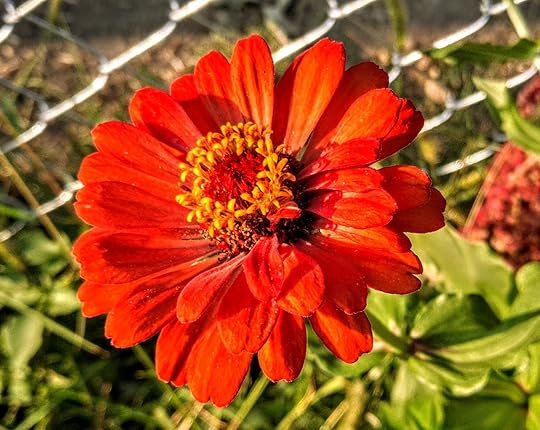
It was a couple of feet into the garden, so I used my walking stick for balance as I leaned over to get a photo, and the walking stick slipped on the foliage, making me lose my balance, and I went down. Sort of ironic, really — if I hadn’t been using the stick for balance, I wouldn’t have fallen. Luckily, I wasn’t hurt except for a small scratch on my arm. Even more luckily, I was able to get up without any trouble.
So that’s a good thing, I suppose — not the fall but learning that I can still get up. I’ve been wondering about that, but I’ve been hesitant to sit on the ground to test myself in case I couldn’t get back on my feet. So I passed the impromptu test and got up with very little trouble. Whew!

It’s been a while — years, maybe — since I’ve fallen, and hopefully it will be a long while before I fall again. I am very careful about such things because I’ve known too many older people whose lives as they knew them came to an end after a fall. (Not because of the fall itself, of course, but because of the injuries the fall caused.)
If ever I need another photo in a hard-to-reach place, I won’t try to balance myself as I lean over to get a close up — I’ll just step right into the garden, and the heck with any damage. One footstep would for sure cause a lot less damage to the garden than an entire falling body. Or I could simply pull out the plants that are in my way. (That’s why the reach was so great to get the photo — the garden had grown out of its bounds.)

I won’t have that same problem next year — that particular garden spot might be mostly empty. Although it’s on the north side of the house, it turns out the be the sunniest (and hottest) place on the property, which is probably why my cool-season grass browned out along there, so it will be the perfect place to plant the desert wildflower seeds I received yesterday. Because it might take a year for the plants to germinate, it’s possible there will be only dirt (and weeds, of course) in that spot.
But for now, there are still some pretty flowers for me to photograph.
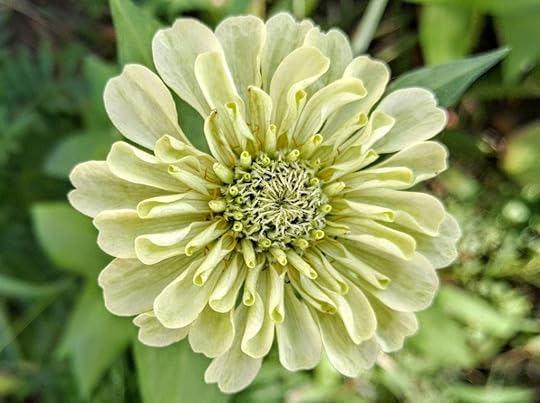
***

Pat Bertram is the author of Grief: The Inside Story – A Guide to Surviving the Loss of a Loved One. “Grief: The Inside Story is perfect and that is not hyperbole! It is exactly what folk who are grieving need to read.” –Leesa Healy, RN, GDAS GDAT, Emotional/Mental Health Therapist & Educator.
September 6, 2022
Variety
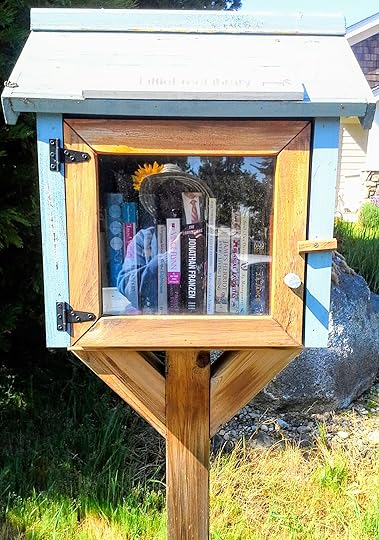
At the library today, I found a notice that our county library district is bringing the Little Free Library program to town. I’ve visited these wonderful mini libraries when I was traveling and was delighted to see it coming here because it’s a great program for a reader. Then I realized I don’t need a little free library — I have a big free library that’s closer to me than any of the little libraries will be.
Still, those little libraries will give me an incentive to walk. I’ve noticed that as I become more settled into home ownership and garden caregivership (no one really owns a garden, one only takes care of it), I have a harder time walking simply to walk. I need a reason and a destination, and visiting a variety of little libraries will give me both of those nudges to get out and walk. That’s my hope, anyway.
After I picked up my books at the library, I bought a variety of items at the variety store. That’s what we called places like dollar stores back in my day, and sheesh. I can’t believe I used such an old-person cliché as “in my day.” Considering that I am still alive, all days are my days.
As I was wandering around the store, I had a brief episode of disorientation. It wasn’t a physical problem but a temporal one — I saw a few Christmas things and for a moment, I had no idea what time of year this is. Christmas? Already? What happened to Autumn? Halloween? Thanksgiving?

I suppose I shouldn’t make disparaging comments about seasons. After all, my Christmas stocking is up, though in my case, it’s not a matter of rushing the season but of forgetting to put the stocking away with the rest of my Christmas things last year, and then being too lazy to drag out the Christmas decoration box again to stow the stocking. This particular stocking was a special gift and is not the sort of thing I can just stuff in anywhere, so I left it hanging. I’ve enjoyed having it up, and anyway, who says a stocking is just for Christmas? This one is beautiful any time of year.
Keeping with the Christmas theme, when I got home and checked my mail, I discovered a wonderful present — wildflower seeds! A variety of seeds are included in each packet: globemallow, desert marigold, brittlebush, chocolate flower, firecracker penstemon, Arizona milkweed and rush milkweed — all perennials. Considering that these are desert plants needing little water and lots of sun (and might take a year to germinate), it will be a whole new gardening experience for me. Luckily, I was gifted with several packets of this wildflower mixture, so I’m set in case of mishaps. Even better, I have the perfect area to plant these seeds — one of the still uncultivated places in my yard. I hesitated to put anything there because I don’t much feel like adding any more time to my watering schedule, so these plants will be great once I get them started.
Whew! Lots of variety, today. And it’s early enough for even more variety to come.
***

What if God decided S/He didn’t like how the world turned out, and turned it over to a development company from the planet Xerxes for re-creation? Would you survive? Could you survive?
A fun book for not-so-fun times.
Click here to buy Bob, The Right Hand of God.
September 5, 2022
Garden of Weedin’
I was outside this morning clearing out weeds and dead annuals and digging up Bermuda grass in preparation for fall planting (lilies and chrysanthemums) and transplanting (New England Asters), when I happened to look up and actually see the garden I was working on. I do see my various gardens, of course, but I tend to focus on what I need to do or what I am actually doing — focusing on the not-so-pretty things, in other words — rather than the gardens as a whole.
It could be that this morning I was looking at the garden from a different angle than I normally do because I was standing in the middle of what was, just a couple of weeks ago, a mishmash of dense grass, weeds, and wildflowers. But whatever the reason, today I really looked and it astounded me to notice that this particular area is becoming something of a garden of Eden instead of the garden of weedin’ that I’ve been dealing with.
I wasn’t the only creature out and about this morning, enjoying the lovely day and the lovely view — a black swallowtail butterfly flitted from flower to flower, so focused on drinking nectar that it didn’t even seem to mind that I was standing there taking pictures.
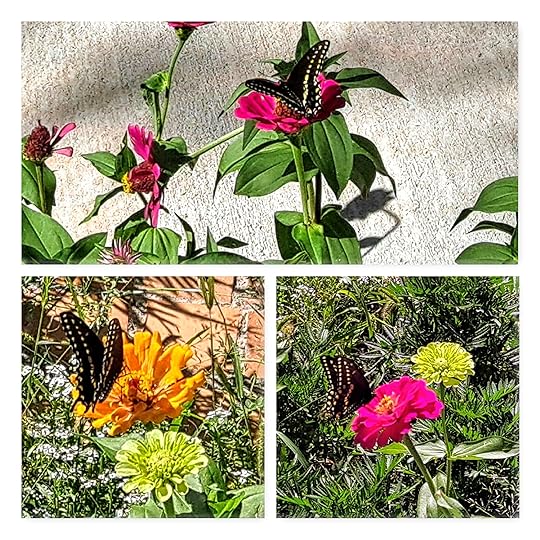
There seems to be a dearth of butterflies in this area of Colorado, so seeing one is a special joy. It also makes all the effort to create a garden even more worthwhile — not just something for me to do, not just an excuse for me to go outside, not just something to look beautiful, but also something that is worthwhile to other creatures, too. (Though to be honest, I could do without the grasshoppers. Prejudice on my part? Perhaps, but the truth is, they are extremely destructive beasts, eating 50% of their body weight every day. They supposedly eat 25% of available forage in the western USA. And, in fact, they ate absolutely everything Jeff and I ever planted except lilacs and Siberian elms; they even ate entire three- and four-foot saplings, bark and all.)
But this is supposed to be a post celebrating the positive aspects of my garden, not the negative ones. And there is much to celebrate today.
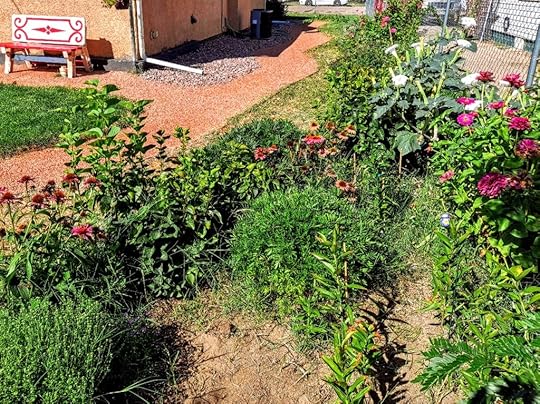
***
Pat Bertram is the author of intriguing fiction and insightful works of grief.



